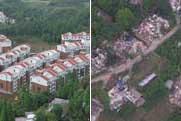China
Move to hospital deliveries saves mothers, infants in Tibet
According to Dorje Pula, director of the Lhaze Health Bureau, only about 16 percent of women gave birth in hospitals before 2000,while the current rate is 62.4 percent.
"Local women would cut themselves off from the world as soon as they realized they were pregnant," he said.
However, the official noted, without proper sanitation, "it was unclean to deliver a baby at home," he said. "If they didn't send for a doctor in time, both the mother and the baby could be in danger."
When the subject of home births vs. hospitals came up, some villagers avoided mentioning superstition and tradition. Instead, they would insist that they couldn't get to a hospital because the roads were so bad. That wasn't entirely untrue.
Tsenam, 27, joined the health bureau in 2003. He recalled at that time, about one-fifth of the villages in the 4,505-square-kilometer county had no roads. "You had to ride a horse to some villages," he said.
Qonglha, 43, has worked in the Lhaze medical clinic for 24 years. "It took three to four hours from some villages to our clinic," she said.



